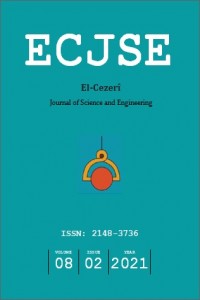Öz
Bu çalışmada CuNiSi toz karışımına ağırlıkça farklı oranlarda (% 2,5, 5 ve% 10) WC parçacıkları toz metalurjisi yöntemi ile ilave edilerek kompozit numuneler üretilmiştir. Hazırlanan tozlar, mekanik alaşımlama cihazı ile 5 ve 10 saat süre ile karıştırılmıştır. Karıştırma işleminden sonra tozlar bir pres ile preslenmiştir. Soğuk presleme işleminde presleme basıncı olarak 600 MPa basınç uygulanmıştır. Üretilen peletlerin sinterleme işlemi atmosfer kontrollü ısıl işlem fırını ile gerçekleştirilmiştir. Sinterleme işlemi argon atmosferinde 900 ℃'de 1 saat uygulanmıştır. Üretilen numunelerin mikroyapısını belirlemek için taramalı elektron mikroskobu (SEM-EDS), üretilen numunelerin iç yapılarında oluşan fazları belirlemek için X-Işını Kırınım yöntemi (XRD) analizi ve WC parçacıklarının sertliğe etkisini belirlemek için mikrosertlik (HV0.05) testi yapılmıştır. Mikroyapı sonuçlarından WC parçacıklarının yapı içinde homojen dağıldığı tespit edilmiştir. Üretilen numunelerde artan WC miktarı ve mekanik alaşımlama süresi ile sertlik değerlerinin de arttığı tespit edilmiştir. Ayrıca deneyler sonucunda % 10 WC takviyeli ve 10 saat mekanik alaşımlama yapılmış kompozit numunede en yüksek sertlik değeri 198 HV0.05 olarak ölçülmüştür.
Anahtar Kelimeler
CuNiSi kompozit Mekanik alaşımlama WC takviye Toz metalurjisi
Kaynakça
- Referans1: Buytoz, S.; Dagdelen, F.; Islak, S.; Kok, M.; Kir, D.; Ercan, E., Effect of the TiC content on microstructure and thermal properties of Cu–TiC composites prepared by powder metallurgy, Journal of Thermal Analysis and Calorimetry. 2014, 117(3): 1277-1283.
- Referans2: Karagöz, Ş.; Yamanoğlu, R.; Atapek, Ş.H., Metalik toz işleme teknolojisi ve prosesleme kademeleri açısından parametrik ilişkiler, Eskişehir Osmangazi Üniversitesi Mühendislik ve Mimarlık Fakültesi Dergisi. 2009, 22(3): 77-87.
Öz
In this study, composite samples were produced by adding WC particles in different proportions (2.5, 5 and 10%) by weight to the CuNiSi powder mixture by powder metallurgy method. The prepared powders were mixed with a mechanical alloying device for 5 and 10 hours. After the mixing process, the powders were pressed with a press. In the cold pressing process, 600 MPa pressure was applied as pressing pressure. The sintering process of the pellets produced was carried out with an atmosphere controlled heat treatment furnace. The sintering process was applied in an argon atmosphere at 900 for 1 hour. Scanning electron microscope (SEM-EDS) to determine the microstructure of the samples produced, X-Ray Diffraction method (XRD) analysis to determine the phases formed in the internal structures of the produced samples, and microhardness (HV0.05) to determine the effect of WC particles on hardness. From the microstructure results, it was determined that the WC particles were homogeneously distributed in the structure. The hardness values increased due to the increased WC amount and mechanical alloying time in the samples produced. In addition, as a result of the experiments, 198 HV was measured as 0.05 in the sample, where 10% WC was added to the highest hardness value and mechanically alloyed for 10 hours.
Anahtar Kelimeler
CuNiSi composite Mechanical alloying WC reinforced Powder metallurgy
Kaynakça
- Referans1: Buytoz, S.; Dagdelen, F.; Islak, S.; Kok, M.; Kir, D.; Ercan, E., Effect of the TiC content on microstructure and thermal properties of Cu–TiC composites prepared by powder metallurgy, Journal of Thermal Analysis and Calorimetry. 2014, 117(3): 1277-1283.
- Referans2: Karagöz, Ş.; Yamanoğlu, R.; Atapek, Ş.H., Metalik toz işleme teknolojisi ve prosesleme kademeleri açısından parametrik ilişkiler, Eskişehir Osmangazi Üniversitesi Mühendislik ve Mimarlık Fakültesi Dergisi. 2009, 22(3): 77-87.
Ayrıntılar
| Birincil Dil | İngilizce |
|---|---|
| Konular | Mühendislik |
| Bölüm | Makaleler |
| Yazarlar | |
| Yayımlanma Tarihi | 31 Mayıs 2021 |
| Gönderilme Tarihi | 4 Ocak 2021 |
| Kabul Tarihi | 9 Şubat 2021 |
| Yayımlandığı Sayı | Yıl 2021 Cilt: 8 Sayı: 2 |
Cited By
Investigation of Manufacturability of TiB2 Particle Reinforced AlCuMg Composites
Uluslararası Doğu Anadolu Fen Mühendislik ve Tasarım Dergisi
https://doi.org/10.47898/ijeased.1137236
T/M Yöntemi ile Üretilen Al-15Zn Alaşımının Sinterleme Sonrası Isıl İşlem Süreçlerinin İncelenmesi
Afyon Kocatepe University Journal of Sciences and Engineering
https://doi.org/10.35414/akufemubid.1144707
Açık Dergi Erişimi (BOAI)
Bu eser Creative Commons Atıf-GayriTicari 4.0 Uluslararası Lisansı ile lisanslanmıştır.





